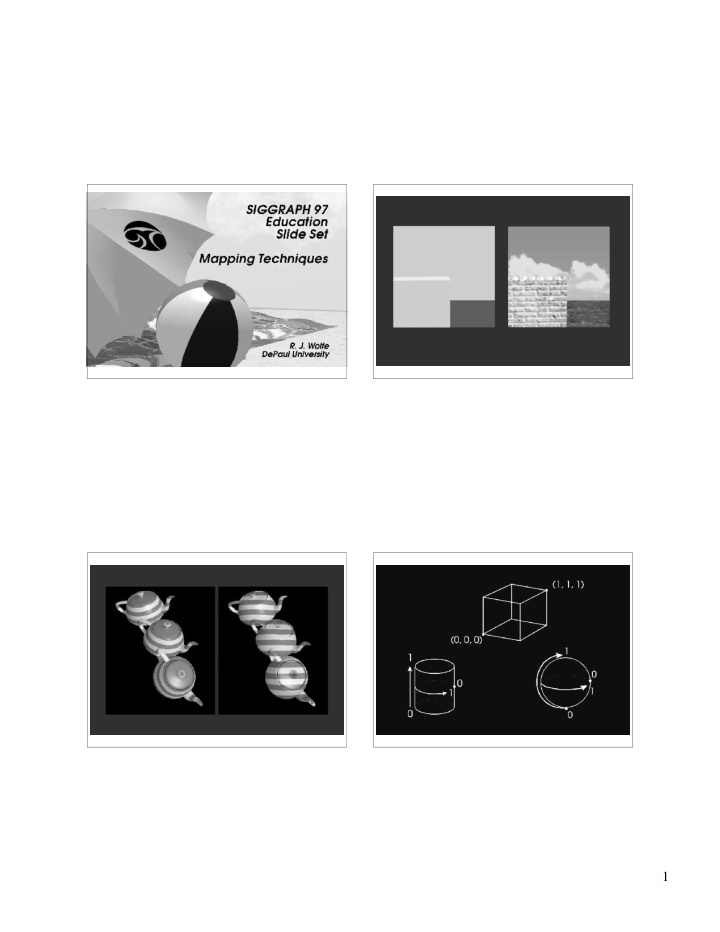



1
2
3
4
5
6
7
8
9
10
11
12
13
14
15
16
17
18
19
References (Blinn, 1978) J. Blinn, Simulations of Wrinkled Surfaces. Computer Graphics 12(3) August 1978, 286-292. (Blinn and Newell, 1976) J. Blinn and M. Newell, Texture and Reflection in Computer Generated Images. Communications of the ACM 19(10) October 1976, 542-546. (Catmull, 1974) E. Catmull, A Subdivision Algorithm for Computer Display of Curved Surfaces. PhD thesis, Department of Computer Science, University of Utah, December 1974. (Catmull, 1978) E. Catmull, A Hidden-Surface Algorithm with Anti-Aliasing. Computer Graphics 12 (3) August 1978, 6-10. (Cook, 1984) R. Cook, Shade Trees. Computer Graphics 18 (3) July 1984 223-231. (Crow, 1981) F. Crow, A Comparison of Antialiasing Techniques. IEEE Computer Graphics and Applications. 1 (1) January 1981, 40-49. (Peachey, 1985) D. Peachey, Solid Texturing of Complex Surfaces. Computer Graphics 19 (3) July 1985, 279-286. (Perlin, 1985) K. Perlin, An Image Synthesizer. Computer Graphics 19 (3) July 1985, 287-296. (Williams, 1983) L. Williams, Pyradmial Parametrics. Computer Graphics 17 (3) July 1983, 1-11. For more information on mapping techniques, see: D. Ebert, F. K. Musgrave, D. Peachey, K. Perlin and S. Worley, Texturing and Modeling: A Procedural Approach. Academic Press, 1994. J. Foley, A. vanDam, S. Feiner and J. Hughes, Computer Graphics: Principles and Practice. 2nd. ed. Addison-Wesley, 1990. A. Watt and M. Watt, Advanced Animation and Rendering Techniques: Theory and Practice. Addison- Wesley, 1992. Credits The dining room seen in slides 6 and 22 was created by Steve van der Burg and rendered using POVRay. The teapots in slides 11 and 14 as well as the raytracing examples on slides 61-63 were done rendered using Craig Kolb’s Rayshade. David Ebert contributed slides 53 and 54. (Thanks, David!) The scene in slides 62 and 63 was created using Steven Chenney’s Sced. Kevin Ferguson developed the "pinwheel texture" to create the Grateful Teapot in slide 50. Pixar and Disney graciously donated the "Toy Story" images (slides 36, 55, and 64). Through Dave Tubbs, Evans and Sutherland generously donated slides 75- 79. All other slides were created with custom rendering software developed at DePaul University. Textures for Texture Mapping the beachball and towel in the title slide came from the SIGGRAPH 97 beachball and committee "surfer" shirt. Many people contributed time, expertise and creativity to this slide set. Thanks to Steve Cunningham for initial discussions that formed the core material for set and for his patience in reviewing many, many drafts. Alain Chesnais made many substantive and constructive comments and suggested the slides on parametric mapping and the visual comparison of lattice and gradient noise. Stephen Spencer, Judy Brown Slides from Rosalee Wolfe and Tom Rieke also made excellent suggestions for improvement to both the images and the text. Jackie White was most gracious in lending her time, despite adverse condition, to help create the title slide. An extra thanks you goes to Stephen Spencer who as Director for Publications supported the development of DePaul University this set. http://www.siggraph.org/education/materials/HyperGraph/mapping/r_wolfe Thanks also to the 1997 Graphics students at DePaul, especially Olivier Buisard, who class-tested these /r_wolfe_mapping_1.htm images. 20
Recommend
More recommend